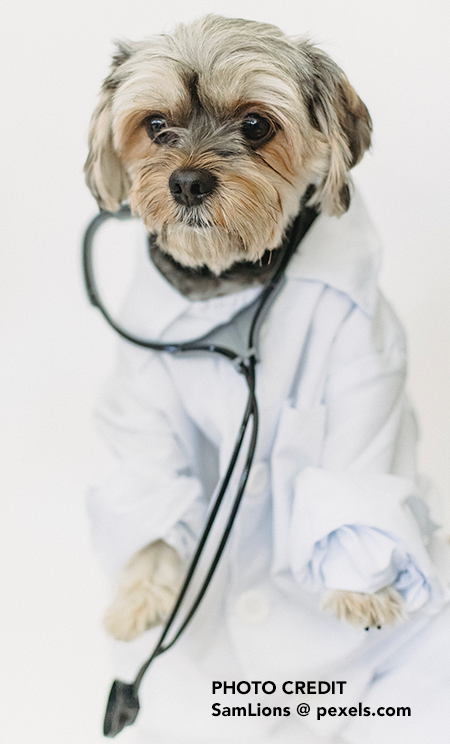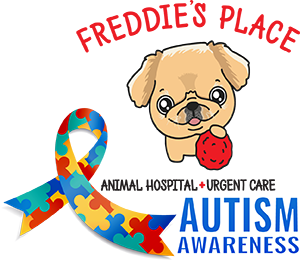 Your Freddie’s Fast Guide to First Aid for your Fur Kids
Your Freddie’s Fast Guide to First Aid for your Fur Kids
April is National Pet First Aid Awareness Month, a month dedicated to education and promotion of standard first aid procedures every pet owner should know. The #FreddieSez team decided that they didn’t know enough about the subject… which means many other pet loving fur families are likely in the same situation. In choosing a starting point, we thought it would be important to identify the major differences between human first aid and pet first aid.
Pet first aid is very different in the diagnosis stage. The main culprit of that is communication. Animals can’t give you a lot of information, so you are left to figure out what the issue is, and what caused the concern, pretty much on your own. Another major difference is that the communication gap also prohibits you from letting the animal understand that you’re trying to help, what steps you are taking and that you need them to cooperate. In a “fight or flight” situation for the pet… “bite and flight” is a real possibility.
Did you know that there are a variety of Pet First Aid Kits on the market? They range in price from about $15 on the low end, to upwards of $200 for a deluxe kit. You’ll find things like gauze, heat & cool packs, tape, anti-diarrhea medication, thermometer, gloves, sponges, antiseptic wound spray and clotting powder, to name a few. Obviously the more expensive kits have more items, a higher quality product, and volume of items included.
Common injuries in Dogs and Cats
Pet first aid treatment has similarities to what you would perform on human. The injuries you’ll likely treat on an animal are things you would see with your children. If your pet is in distress, you’ll need to triage the issue. Information is power, so look for things like:
(NEVER give your pet over the counter medication prescribed or designed for humans. Wrong doses, not fully understanding the impact a human med could have on an animal, or combining medications without consulting your veterinarian can make the situation worse and even lead to death)
To protect yourself and the animal during the treatment phase, take added precautions to assure you are not accidentally bitten or scratched. In addition, these safety measures will help assure the animal is also stabilized and cannot hurt themselves by attempting to respond to the unknown or flee the scene.
Steps to Triage
CPR and your Pet
In some extreme or traumatic injury cases, you may need to perform CPR on your dog or cat. Like humans, if a dog is not moving or breathing, if they do not have a pulse or are not responding, you may need to act fast and attempt CPR to bring them back to life.
Reasons your pet might be in distress and needing CPR vary. Look for signs of physical trauma, choking or heat stroke. Be sure the animal has no pulse, heartbeat and isn’t breathing. Performing unneeded CPR could cause severe damage to your pet, even resulting in death.
How to perform CPR on a Dog or Cat
- 1
Assure your pet is truly in a state needing CPR. Gently shake the dog in an attempt to see a visible response. Call their name, or A name (dog, buddy, boy, sweetheart… verbally make sounds in a loving and gentle tone)
- 2
Look the dog over for signs of breathing. Is the chest or stomach rising up and down? If you hold fingers over the nose and mouth, can you feel the air on an exhale?
- 3
Open the pets mouth, pull the tongue forward and look for signs of foreign objects or a blockage in their mouth or throat. If one is visible, you can attempt to remove it. Use slow and calm movements and be aware the animal could bite if they are still conscious
- 4
Check for a heartbeat under the left front leg OR on the thigh where the leg meet the body. Count the pulse beats for 15 seconds. You can then multiply by 4 to get an idea of their pulse rate. Depending on the size of the animal, the optimal rate should be between 70 and 40 BPM
- 5
If there is no response, have someone call for help while you continue to work on the animal. A local emergency or urgent care vet can provide over the phone assistance in this process… so have the person put you on speaker phone so you are speaking directly with the source of support
- 6
Place the animal on a flat surface. Lay the pet on it’s side, with legs in normal resting/stretched out position
- 7
Position yourself behind the animal, with your knees tightly up against it’s back as a brace. Place yourself over the pet, with your shoulders aligned with your hands at the chest, lock your elbows. This will allow you to push down with the biggest amount of pressure in the heels of your hands (this may position you in a forward leaning position… that is okay)
- 8
Give steady and rhythmic chest compression at a rate of about 100 to 120 per minute. Count them out loud to assure you’re keeping the timing and meter. Your heels should push down on the rib cage about ½ of the chest length. Keep this pace up for up to 5 minutes, being sure you are releasing the pressure after each downward push (to help you keep a steady beat at the right rate, you can sing or hum the Bee Gee’s hit “Staying Alive”)
- 9
Every 30 pushes down, the animal will need air pushed into it’s lungs. You’ll do this through the nose, not the mouth. Cup your hands over the snout and breathe into the nostrils. You need a tight seal when you do this. You’ll see the chest rise and fall as you perform this process. If you have another person, a partner, you can each take a part of the cycle (compression’s or breathing) and then switch positions after about 1:30 to 2:00
- 10
After five minutes, stop and access the condition of the animal. Are they breathing on their own? Is there a pulse or heartbeat? If not, resume the CPR process. The guideline is that you continue CPR for three cycles of five minutes each, looking for signs of response every 5 minutes
- 11
At the end of the third cycle, if you do not see or feel signs of response… then there is likely not going to be a recovery. In those cases, you must keep in mind that you tried everything in your power to revive the animal
- 12
If the pet does revive, keep in mind that there is a possibility of needed “after care”, just like in humans. The animal needs to see a professional for potential injured ribs from the CPR process, extreme stress, and a full medical exam to determine the cause of the incident
If you’re in your home area, know where the animal emergency and urgent care hospitals are located. If you’re not near home, a Google search will show places near you to take the animal for immediate after care and treatment.
Did you know that The American Red Cross offers an online app to assist you in first aid diagnosis and treatment for your pets? It’s called the Pet First Aid app and can be found in both the Apple and Android app stores. There are tons of books on the subject as well, both downloadable and physical, available through outlets like Amazon. If you are looking to assure you have all the angles covered and are prepared for anything, there are online courses in animal first aid you can sign up for, or take an in person class. Check online for locations, starting with your local pet stores.
Be sure to take your pets for normal wellness checkups at your preferred Vet. If you’re in the San Diego County area, remember that Freddie’s Place can offer both urgent and wellness needs on a 24/7/365 basis.
Good dental hygiene, ongoing maintenance care, flea/tick prevention and knowing your pet’s breed specific/genetic illnesses or predetermined potential issues is always a big help towards being prepared for any problems. In the end, stuff happens… and it happens when you least expect it. The best way to be prepared for anything to invest in a plan and educate yourself. As G.I. taught us all “knowing is half the battle” and being prepared is the other half!
That’s all for today from #FreddieSez. We hope this information was a worthwhile read and that you might have learned a thing or three. If you like what you read, keep in mind that we have a library of blog entries with topics that might interest any pet owner.
Until next week, have a fantastic Easter Holiday, be wary of what foreign or new foods your pet might be exposed to at holidays meals, keep your fur kids safe and sound as new humans (or other animals) enter their lives during gatherings or parties. It’s your pet’s home, too… treat the space and the animal with respect. Till we meet again, be safe and pet crazy. #FreddieSez





Leave A Comment